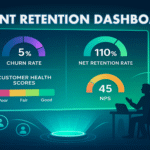Now Reading: Leveraging Data Analytics for Sales Optimization
-
01
Leveraging Data Analytics for Sales Optimization

Leveraging Data Analytics for Sales Optimization
Introduction
Data analytics reveals customer behavior patterns and measures performance metrics of all types. Companies can use predictive analytics to understand what customers want next. They can then adjust their sales approach and create customized service. British Airways proved this strategy works when they improved their conversion rates and customer loyalty by a lot through their analytics-based sales and marketing.
Harley-Davidson's business analytics optimization led to a 2,930% increase in New York sales in just three days. This soaring win shows how informed decisions can reshape a company's sales performance. Analytics helps businesses track performance indicators, predict trends and spot areas that need improvement.
This piece will show you the exact tools, frameworks and strategies you need to achieve results like these. We’ll help you turn your raw data into applicable information that propels sales growth – from linear optimization models to live performance dashboards.
Core Analytics Tools Selection
The right analytics tools are the foundations of successful sales optimization. Organizations that use integrated analytics tools see notable improvements in their decision-making processes and streamline processes.
CRM Integration Requirements
A well-integrated CRM system acts as the central hub to manage customer data. Industry research shows only 28% of businesses have fully integrated their applications29. Companies must make API-based integration their priority, which 60% of IT leaders see as vital to digital transformation29.
The main requirements for CRM integration include:
- Natural data flow between systems
- Up-to-the-minute data processing capabilities
- Strong security features
- Detailed sales reporting functionality
Business Intelligence Platforms Comparison
Modern BI platforms give distinct capabilities for data analysis and visualization. Several platforms stand out in the market based on their unique strengths. Microsoft leads in cloud-enabled digital transformation, while Qlik excels in data integration and quality analytics30. On top of that, MicroStrategy focuses on unified BI delivery, and Sisense specializes in workflow embedding30.
Organizations should think about these key functionalities when evaluating BI platforms:
- Advanced analytics capabilities for complex data processing
- Customizable dashboards for executive decision-making
- Self-service features for team-wide data access
- Multi-source data integration support
- Automated report generation capabilities31
Custom Analytics Solutions
Popular analytics platforms offer extensive features, but some scenarios need custom solutions. Organizations often need tailored analytics when they operate in niche markets or handle unconventional user flows32. Custom solutions are a great way to get benefits for companies that need:
- Up-to-the-minute processing of massive datasets
- Industry-specific KPI tracking
- Unique data visualization requirements
- Integration with proprietary systems
Data quality and governance play crucial roles in the implementation process. Custom solutions help identify inefficiencies in inventory replenishment cycles and resource allocation by analyzing operational data33. These solutions help organizations establish clear metrics to measure analytics’ effect on business performance33.
Analytics framework should include both reporting and intelligence capabilities to get optimal results. All the same, reporting tools alone cannot perform advanced analytics such as predictive or prescriptive analysis6. A balanced approach that combines standard tools with custom solutions often produces the best outcomes.
Organizations can create a detailed analytics ecosystem that propels development and business growth by properly integrating CRM systems, BI platforms, and custom solutions. This integrated approach ensures data flows naturally across all systems and enables teams to make informed decisions based on accurate, up-to-the-minute information.
Linear Optimization Models
Mathematical optimization models are powerful tools that maximize sales performance with evidence-based decision making. These models use objective functions and constraints to help businesses determine the best resource allocation7.
Sales Territory Mapping
The right sales territory optimization can boost revenue growth. Well-lined up territories show a 7% increase in performance without extra resources8. Organizations can divide regions based on several key factors using evidence-based territory mapping:
- Customer density and market potential
- Geographic constraints
- Travel time optimization
- Workload distribution
Modern territory mapping software makes the optimization process 95% faster. It gives accessible and secure solutions to everyone involved8. Companies that use territory management software see big improvements in their sales operations9.
The mapping process looks at account profitability, product fitness, purchasing power, and rep experience to build balanced territories10. This approach cuts unnecessary costs by sizing the sales force correctly and filling coverage gaps8.
Resource Allocation Framework
The way resources are allocated is vital to boost sales performance and profitability. The framework looks at three main resources11:
- People (sales staff)
- Time management
- Budget distribution
Sales leaders should use a calendar-driven planning cycle that brings all team members together early12. This approach has sections for:
- Original sales resource forecasts from team leaders
- Territory design scenario creation
- Final adjustments and approval
- Team rollout implementation
Resource forecasting helps predict future needs accurately. Organizations can plan their spending and use resources better13. A workload analysis creates fair territories that improve seller earnings and put sales representatives closer to customers12.
The optimization model looks at micro-markets and hotspots. It makes sure resources tap into future opportunities12. Linear programming techniques help organizations cut costs while maximizing profits through systematic resource distribution14.
A regular look at customer locations shows new ways to approach the market. This becomes especially helpful at the time of hiring sellers in customer-heavy areas12. This evidence-based method prevents common problems like understaffing or overstaffing. Budget allocation works better across different sales areas11.
Organizations that use these optimization models well achieve balanced workloads and keep their teams longer. Many organizations face up to 20% annual turnover in sales teams8. A fair territory distribution and resource allocation are vital to keep succeeding.
Predictive Analytics Implementation
Predictive analytics pioneers modern sales optimization. It helps businesses make analytical decisions through statistical algorithms and machine learning techniques. Companies can predict future outcomes with great precision by analyzing past data and current market trends.
Lead Scoring Algorithm Development
Lead scoring turns subjective evaluation into a scientific method that spots high-potential prospects. Companies analyze multiple data points, including demographic information, purchase history, and online behavior patterns15. The system gives numerical values to leads based on their conversion likelihood, which helps sales teams focus their outreach efforts16.
A good lead scoring system needs both explicit and implicit data. Explicit data includes industry specifics, service areas, and budget plans. Implicit data shows user behavior metrics like web visits and click-through rates17. This combined approach creates a detailed system that makes the sales process efficient and boosts conversion rates.
Sales Forecasting Models
Sales forecasting plays a vital role in business planning. It helps companies estimate future revenue streams accurately18. Companies that use CRM-based forecasting systems see much better accuracy than those using traditional spreadsheet methods18.
The forecasting system has these key parts:
- Historical trend assessment
- Strategic business plan integration
- Competitive market analysis
- Resource allocation planning1
Smart companies use time-based dashboards and performance indicators to track velocity calculations, trending analytics, and seasonal changes1. This analytical approach helps companies make smart decisions about inventory, workforce planning, and resource distribution.
Customer Churn Prevention
Keeping existing customers costs less than finding new ones. Predictive analytics spots potential churners early, so companies can start retention efforts quickly19. Companies can see early warning signs by looking at customer behavior patterns and engagement metrics15.
The churn prevention model looks at several factors:
- Customer interaction frequency
- Product usage patterns
- Service engagement levels
- Purchase history trends20
Automated workflows let companies act fast when churn signs appear19. These systems send predictions straight to CRM platforms and marketing tools, which creates quick, personalized retention campaigns.
Predictive analytics reveals deep insights about customer behavior. Companies learn why customers might leave at different times19. This detailed knowledge helps create targeted solutions and improve customer satisfaction before problems arise.
Companies must regularly check and improve their predictive models. The models should stay general enough to work with training and testing sets from different time periods and customer types21. This approach keeps models accurate and reliable across market conditions and customer groups.
Real-time Performance Dashboards
Real-time dashboards have changed the way sales teams track, analyze, and act upon performance data. Organizations that use dashboard analytics show substantial improvements in decision-making speed and accuracy based on extensive research2.
KPI Visualization Design
Clear and practical insights are essential for effective KPI visualization. Sales dashboards must organize data into clear, useful visualizations that update in real-time2. The best dashboard designs include:
- Pipeline value tracking
- Revenue forecasting
- Deal status monitoring
- Sales cycle analysis
A well-designed dashboard makes information access easier. Sales teams can focus on selling instead of administrative tasks3. These dashboards ensure data accuracy through proper CRM system integration without manual spreadsheet management3.
Sales Team Performance Metrics
Performance metrics are the life-blood of sales optimization. Sales rep performance is best measured through three key indicators2:
- Conversion rate
- Total revenue generated
- Quota attainment percentage
The core team tracks activity participation, opportunities in pipeline, and customer retention rates among other metrics2. Managers can quickly identify coaching opportunities when performance falls below standards through automated reporting systems2.
Sales performance dashboards work best when they show:
- Individual salesperson achievements
- Pipeline health indicators
- Product performance analytics
- Territory-specific results
Modern dashboard solutions let users customize views of pending, ongoing, and achieved quotas22. Sales teams that use real-time performance tracking consistently show improved quota achievement rates and reduced sales cycle lengths23.
Performance dashboards provide several operational benefits:
- Instant access to critical sales data
- Automated performance tracking
- Improved team collaboration
- Evidence-based decision making
Sales leaders can track progress toward goals, manage pipeline effectively, and establish forecasts based on reliable data through proper dashboard setup24. These explanations are a great way to get insights about trends, find new opportunities, and address potential risks before they escalate25.
Organizations create a detailed analytics ecosystem that streamlines processes for continuous improvement in sales performance by combining reporting and intelligence capabilities. This systematic approach ensures that data flows naturally across all systems. The core team can make informed decisions based on accurate, real-time information3.
Data-Driven Decision Framework
A robust data-driven decision framework strengthens organizations to make informed choices based on concrete evidence. Companies can identify growth opportunities and optimize their sales strategies through systematic analysis of business metrics.
Automated Reporting System
Automated reporting software streamlines data collection, processing, analysis, and visualization without human intervention. This systematic approach reduces report generation time by up to 90%26. The framework includes these critical components:
- Data preparation with automated ingestion from multiple sources
- Combined storage in data warehouses and marts
- Advanced analytical processing capabilities
- Customizable report distribution systems
Modern reporting solutions provide role-based access control and configurable permission settings that ensure data security compliance with regulations like GDPR and HIPAA26. The implementation cost for a complete BI solution with built-in report automation ranges from INR 6.75 million to INR 8.44 billion26.
Action Item Generation
AI-powered action item generation reshapes the scene of meeting productivity by automatically identifying and extracting applicable tasks. This technology saves approximately 90% of manual note-taking time5. The system operates through:
- Automated task identification
- Priority assignment
- Progress monitoring
- Deadline tracking
The BERT model implementation for action item detection achieved remarkable results and reached 87% accuracy originally. The model attained 90% accuracy while maintaining a reduced size of 128 MB after optimization efforts and improved data quality4.
ROI Tracking Methods
A complete approach measures marketing and sales initiatives’ effect on ROI tracking. Organizations that implement proper ROI tracking see substantial improvements in budget allocation and performance optimization. Marketing ROI typically measures at a 5:1 ratio, with exceptional performance at 10:127.
Businesses should focus on these elements for accurate ROI measurement:
- Total revenue tracking
- Gross profit calculation
- Net profit assessment
- Customer lifetime value analysis
Organizations must account for various expenses to boost ROI tracking precision27:
- Overhead costs
- Agency fees
- Media investments
- Creative development
Unified marketing measurements combine disparate data points into cohesive insights that help understand both online and offline touchpoints better27. Businesses can identify trends, patterns, and opportunities across multiple channels at once through proper implementation.
Data quality and accuracy are the foundations of the framework’s success. Poor data quality often results in flawed analysis and misguided decisions28. Organizations must establish robust methods for:
- Data validation
- Quality assurance protocols
- Regular system audits
- Performance measuring
Machine learning and AI technologies have substantially advanced analytical capabilities and process big amounts of data at unprecedented speeds28. These tools enable:
- Predictive modeling for forecasting
- Sentiment analysis for customer insights
- Anomaly detection for fraud prevention
- Natural language processing for text analysis
Organizations can make decisions based on facts instead of biases by implementing this complete framework, which ended up driving improved business outcomes28. Regular assessment and refinement of these systems ensure continued effectiveness and arrangement with organizational goals.
Conclusion
Business analytics has proven to optimize sales and deliver substantial revenue growth. This piece explores the key components that help organizations turn raw data into practical insights.
Analytics tools integrated into sales operations deliver measurable results. Modern CRM systems work alongside business intelligence platforms to create robust ecosystems that manage and analyze data. Linear optimization models make territory mapping and resource allocation efficient. Predictive analytics helps businesses spot market trends early and reduce customer losses.
Performance dashboards give sales teams immediate feedback to respond quickly to market shifts. On top of that, automated reporting systems cut down manual work and let teams concentrate on strategic decisions instead of paperwork.
Harley-Davidson’s impressive sales growth shows the concrete benefits of implementing analytics. Companies that use these frameworks consistently get better conversion rates, keep more customers, and speed up their sales cycles. Smart businesses welcome informed decision-making to secure lasting growth and market dominance.
Frequently Asked Questions
Q1. How can business analytics impact sales performance?
Business analytics can significantly boost sales performance by enabling data-driven decision-making, optimizing resource allocation, and providing predictive insights. Companies using integrated analytics tools have experienced notable improvements in conversion rates, customer retention, and overall revenue growth.
Q2. What are the key components of an effective analytics framework for sales?
An effective analytics framework for sales typically includes CRM integration, business intelligence platforms, linear optimization models, predictive analytics implementation, real-time performance dashboards, and automated reporting systems. These components work together to provide comprehensive insights and drive sales optimization.
Q3. How does predictive analytics help in preventing customer churn?
Predictive analytics helps prevent customer churn by analyzing customer behavior patterns, engagement metrics, and historical data to identify potential churners before they leave. This allows businesses to implement targeted retention strategies and take proactive measures to improve customer satisfaction.
Q4. What benefits do real-time performance dashboards offer to sales teams?
Real-time performance dashboards provide instant access to critical sales data, enabling sales teams to track progress toward goals, manage pipeline effectively, and make data-driven decisions. They also help in identifying trends, discovering new opportunities, and addressing potential concerns promptly.
Q5. How can companies ensure the effectiveness of their data-driven decision framework?
To ensure the effectiveness of a data-driven decision framework, companies should focus on data quality, implement robust validation and quality assurance protocols, conduct regular system audits, and perform benchmarking. Additionally, leveraging machine learning and AI technologies can enhance analytical capabilities and provide more accurate insights for decision-making.
References List
[1] – https://www.anaplan.com/blog/sales-forecasting-guide/
[2] – https://www.salesforce.com/sales/analytics/sales-dashboard-examples/
[3] – https://www.tableau.com/dashboard/sales-dashboard-examples-and-templates
[4] – https://kadellabs.com/action-item-detection-using-bert-model/
[5] – https://screenapp.io/features/ai-action-item-generator
[6] – https://www.collaborat.com/guide-to-selecting-sales-analytics-software-tools/
[7] – http://home.ubalt.edu/ntsbarsh/business-stat/opre/partVIII.htm
[8] – https://www.espatial.com/territory-management/territory-optimization
[9] – https://www.nomadia-group.com/in/resources/blog/how-to-optimize-your-sales-territories-for-maximum-coverage-and-efficiency/
[10] – https://www.oracle.com/in/cx/sales/sales-territory-optimization/
[11] – https://fullenrich.com/glossary/sales-resource-allocation-efficiency
[12] – https://www.espatial.com/blog/master-sales-resource-allocation
[13] – https://www.nutshell.com/blog/resource-management-for-sales
[14] – https://www.vskills.in/certification/tutorial/building-linear-optimization-models/
[15] – https://www.sales-i.com/blog/6-benefits-of-predictive-analytics.html
[16] – https://pipeline.zoominfo.com/marketing/lead-scoring
[17] – https://www.nected.ai/blog/lead-scoring-tools
[18] – https://www.salesforce.com/in/sales/analytics/sales-forecasting-guide/
[19] – https://www.pecan.ai/solution/customer-churn/
[20] – https://www.tooli.qa/insights/customer-churn-prevention-using-predictive-analytics
[21] – https://blog.dataiku.com/how-to-address-churn-with-predictive-analytics
[22] – https://www.zoho.com/crm/performance-management.html
[23] – https://www.salesforce.com/in/sales/performance-management/
[24] – https://www.qlik.com/us/dashboard-examples/sales-dashboards
[25] – https://blog.coupler.io/sales-dashboards/
[26] – https://www.scnsoft.com/data/reporting/automated
[27] – https://www.marketingevolution.com/marketing-essentials/marketing-roi
[28] – https://asana.com/resources/data-driven-decision-making
[29] – https://www.salesforce.com/in/crm/crm-integration/
[30] – https://www.gartner.com/reviews/market/analytics-business-intelligence-platforms
[31] – https://www.spiceworks.com/tech/big-data/articles/top-ten-business-intelligence-platforms/
[32] – https://aqfer.com/how-to-build-a-custom-analytics-solution/
[33] – https://www.datadice.io/en/custom-analytics















